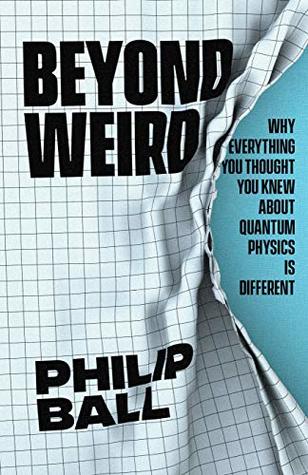More on this book
Community
Kindle Notes & Highlights
by
Philip Ball
Read between
December 28, 2018 - January 7, 2019
Here are the most common reasons for calling quantum mechanics weird. We’re told it says that: • Quantum objects can be both waves and particles. This is wave-particle duality. • Quantum objects can be in more than one state at once: they can be both here and there, say. This is called superposition. • You can’t simultaneously know exactly two properties of a quantum object. This is Heisenberg’s uncertainty principle. • Quantum objects can affect one another instantly over huge distances: so-called ‘spooky action at a distance’. This arises from the phenomenon called entanglement. • You can’t
...more
Reading about quantum theory often feels a little like reading anthropology: it tells of a far-off land where the customs are strange.
quantum mechanics is not really ‘about’ quanta: the chunking of energy is a fairly incidental (though initially unexpected and surprising) outcome of it.
So the phrase ‘wave–particle duality’ doesn’t really refer to quantum objects at all, but to the interpretation of experiments – which is to say, to our human-scale view of things.
The wavefunction is not a description of the entity we call an electron. It is a prescription for what to expect when we make measurements on that entity.
This picture of quantum mechanics is said to be ontic: from ‘ontology’, meaning the nature of things that exist. The alternative view is that the wavefunction is epistemic: as Heisenberg asserted, it refers only to our state of knowledge about a system, and not to its fundamental nature
So, said Bohr, we had better just stop there. As he put it: There is no quantum world. There is only an abstract quantum physical description. It is wrong to think that the task of physics is to find out how nature is. Physics concerns what we can say about nature. The is the central tenet of the so-called Copenhagen Interpretation of quantum mechanics, developed by Bohr and his colleagues in the Danish capital during the mid-1920s.*4 It’s an interpretation that doesn’t so much tell us ‘what is happening’, but rather, proscribes what we can legitimately ask about it.
We just don’t know how to picture quantum spin. It is some property that makes the particle respond, like a magnet, to an external magnetic field, and that’s all. There is no classical analogue.
It turns out that there are two distinct classes of fundamental particle: those with spin quantum numbers that are integers (0, 1, 2 . . . ) and those with half-integer spin (1/2).*2 The former are called bosons, and they constitute all the ‘carrier’ particles of fundamental forces: gluons (carrying the strong nuclear force that binds together the constituents of atomic nuclei), so-called W and Z mesons (carrying the weak nuclear force involved in radioactive beta decay) and photons (carrying the electromagnetic force). You will probably have heard also of the Higgs boson, which is involved in
...more
At first glance, the MWI looks like a delightfully simple answer to that mysterious vanishing act. It says that none of the states vanishes at all, except to our perception. It says, in essence, let’s just do away with wavefunction collapse altogether.
If all the possible outcomes of a quantum measurement have a real existence, where are they, and why do we see (or think we see) only one? This is where the many worlds come in. DeWitt argued that the alternative outcomes of the measurement must exist in a parallel reality: another world. You measure the path of an electron, and in this world it seems to go this way, but in another world it went that way.
You might in any case want to ask: where are all these ‘other worlds’ anyway? The usual answer is that they are in Hilbert space – the mathematical construct that contains all the possible solutions of the variables in the Schrödinger equation. But Hilbert space is a construct – a piece of math, not a place. As Asher Peres has put it, ‘The simple and obvious truth is that quantum phenomena do not occur in a Hilbert space. They occur in a laboratory.’
Belief in the MWI seems to demand that we regard the math of quantum theory as somehow a fabric of reality. We have nowhere to put those Many Worlds, except in our equations. Some physicists suspect that this amounts to falling so deeply in love with your mathematical tools that you decide to live in them.
According to the way things look right now, the key difference between classical and quantum mechanics is that the first calculates trajectories of objects while the second calculates probabilities (expressed as a wave equation). Its probabilistic character doesn’t make quantum mechanics unique in itself: coin tossing is about probability too, but you don’t need quantum mechanics to explain it. What makes quantum theory so puzzling is that sometimes what we observe seems to force us to speak as though the quantum coins were both heads and tails at once.
Ontic theories, such as hidden-variables models and the de Broglie–Bohm interpretation, take the view that quantum objects have objective properties – which means in turn that wavefunctions are ‘real’ entities, having a one-to-one correspondence with properties that don’t depend on their being measured. The Copenhagen Interpretation, on the other hand, is epistemic, insisting that it’s not physically meaningful to look for any layer of reality beneath what we can measure.


